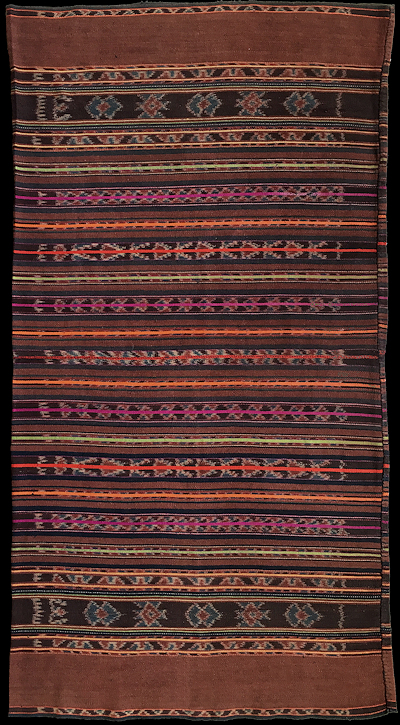| |
 
 | | | |
314 Solor Archipelago, Pantar
Kafate (sarong)  
| | Locale: | Kabir village, west coast of eastern Pantar, made by Alurung (Alorese speaking) people, almost certainly on Ternate | | Period: | ca. 1940 | | Yarn: | Cotton mixed with kolon susu, hand-spun, medium, and silk pinstripes | | Technique: | Warp ikat | | Panels: | 2 | | Size: | 68 x 127 cm (2' 2" x 4' 2") LW: 1.87 | | Weight: | 675 g (23.8 oz), 391 g/m2 (1.28 oz/ft2) | | Design: | A type called tenapi balang (Peni & McIntosh Type B). Another name for it is tenapi kolon susu sontoraja. Kolon susu, fibre from milkweed pods, was blended with the cotton - a technique used only on Pantar, Ternate and Buaya. The slightly purplish red was probably achieved with sappan wood and a dye made from sea urchins. The numerous pinstripes in a variety of colours including cyclamen, orange and two shades or green are made of toko bought silk, available in the area until the second world war. Note the similarity with its indigo dominated sister PC 315. A a few design elements recall ikat made on Ternate and Buaya, and western Alor, such as the drawing in the widest ikated bands with their filled in shapes, and the rare blue; a petrol-like indigo that is very characteristic. There is a clear stylistic correspondence with the ikat textiles of the other Alorese speaking islands Ternate and, Buaya and of southwestern Alor. | | Comment: | Such examples of Alurung ikat with some age are rare, and as yet do not feature in the literature. Sturdy cloth, rather heavy for its size. The sturdy feel no doubt is partly due to the kolon susu, which is blended in partly for this reason - the other reason being the scarcity of cotton on the island, only parts of which are fertile, so that growing cotton goes at the expense of producing food. Most cotton is probably obtained by barter with other islands, as it is done on neighbouring Ternate. Immaculate condition. | | Background: | Chapters on Solor Archipelago and Pantar. | | Compare: | 184 315 | | Sources: | Name of the type was provided by Linda McIntosh. See also Peni & McIntosh, article in Textiles Asia, Vol. 12, Issue 1. 2020. East Pantar origin confirmed by Alorese souce. For more on the use of milkweed fibre see Ten Hoopen, Ikat Textiles of the Indonesian Archipelago, chapter on Solor and Alor Archipelago, which in this respect relies on the work of Emilie Wellfelt. | | |

©Peter ten Hoopen, 2024
All rights reserved.
|
|


